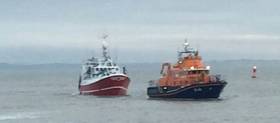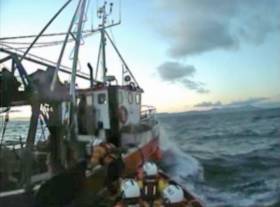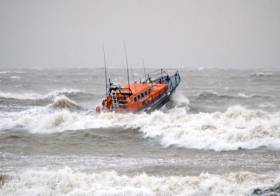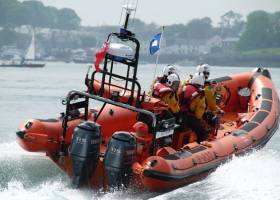Displaying items by tag: RNLI
Lifeboat crew with Rosslare RNLI had an early morning callout today to a 22–metre fishing vessel which had suffered engine failure near Tuskar Rock lighthouse.
The lifeboat pagers went off at 5.30am with the lifeboat launching a short time later. Rosslare RNLI arrived on scene at 6am to find a 22-metre fishing vessel with four people on board which had suffered engine failure, 2km northwest of Tuskar Rock lighthouse.
The volunteer lifeboat crew immediately established a tow in moderate sea conditions and brought the vessel in to Rosslare Europort, arriving at 7.15am.
Commenting on the callout Rosslare RNLI Lifeboat Press Officer Jamie Ryan said, ‘This was an early morning wake-up call for our volunteer lifeboat crew but they are always ready to respond. Thankfully conditions were good and the lifeboat crew were on scene quickly. Rosslare is a busy port with a lot of vessels coming and going so it is important that when one suffers a problem that there is help close by and we can escort them to safety. Everything went to plan and the four fishing crew are safe and well.’
Kilkeel Lifeboat Aids Fishing Boat On Fire
#RNLI - Kilkeel RNLI went to the aid of the fishing boat which reported a fire in its engine room on Wednesday evening (24 February).
The 14m fishing vessel, with two men on board, was 11 miles south-east of Kilkeel when the incident was reported at 5.20pm.
Arriving on the scene, the lifeboat crew found that the fire had been extinguished but there was a problem with the steering.
Kilkeel RNLI volunteer crew member Alexander McCauley boarded the stricken vessel to assess the damage and address the steering issues.
Once repaired, the fishing vessel headed for Kilkeel but after about two miles under her own steam the steering broke down again, with the rudder locked to port.
The vessel was then taken under tow by the Kilkeel lifeboat for the remaining five miles to Kilkeel Harbour.
Another local fishing boat, Oceanus with skipper Neil McKee, followed the vessels to Kilkeel, while the Irish Coast Guard helicopter Rescue 116 was also in attendance till the vessel was safely under tow.
The Clogherhead RNLI lifeboat was also dispatched to the scene but was released from duty once the team's Kilkeel colleagues had the situation under control.
Weather conditions during the callout were described as good.
"Putting a crew member aboard another vessel and towing the vessel is something that we practice regularly and everything went smoothly," said Kilkeel RNLI helm Gerry Smyth. "With the conditions being good the rescue went exactly as planned.’
John Fisher, Kilkeel RNLI lifeboat operations manager, added that the successful rescue demonstrated the excellent working relationships that have been developed between the coastguard, Clogherhead RNLI, Rescue 116 and the Kilkeel lifeboat crew.
Kilkeel RNLI's crew for the callout comprised helm Gerry Smyth and crew members William Charleton, Alexander McCauley and Sam Graham.
Malahide Yacht Club Wins All Ireland Nautical Table Quiz in aid of the RNLI
The first All Ireland Nautical Table Quiz in aid of the RNLI took place last Friday evening in the Marine Hotel, Sutton in County Dublin.
There was a great turn out, including a team from the Howth RNLI crew. The winning team was Malahide Yacht Club. They received first prize and the All Ireland Nautical Table Quiz Perpetual Trophy.
Presenting the prizes to the winners, John Craddock, Commodore of Howth Sailing and Boating Club, thanked the very generous sponsors and the voluntary contribution of club members for making it all happen. Plans are already underway for next years Quiz which will be bigger and better.
The event raised close to €2,000
Survivor Helps RNLI Promote Water Safety At Ireland Angling Show
#WaterSafety - Shore angler Colm Plunkett, who survived a near drowning incident last August, assisted the RNLI community safety team at the Ireland Angling 2016 show last weekend (20-21 February).
Plunkett shared his experience with hundreds of fellow anglers and watersports enthusiasts from all over Ireland – and promoted the wearing of lifejackets to help prevent the loss of life along coasts, rivers and lake shores.
As previously reported on Afloat.ie, Plunkett was swept from rocks when he was angling near Dursey Island in Cork last August. He spent 55 minutes fighting for his life before he was rescued. He was wearing a lifejacket at the time.
“My main message is that I wasn’t lucky - I was prepared but not nearly as much as I needed to be," he said. "A splash hood on my lifejacket would have saved me from an experience somewhat akin to waterboarding. A personal locator beacon (PLB) would have brought the coastguard directly to me should I have continued out to sea. It would also have initiated a distress call if I had been fishing on my own, which I often do.
"The lifejacket saved my life; the prearranged plan with my daughter saved my life; the cell phone saved my life; the emergency services saved my life. And if through telling others of my harrowing experience, on a ‘calm’ sea, I can get other fishermen to wear a life jacket then it was an experience worth having but definitely not worth repeating."
Plunkett also suggested a prearranged plan for anyone heading out on or near the water:
- Wear a well maintained lifejacket with crotch straps at all times.
- No one else should enter the water in an emergency.
- Call 112 or 999 immediately and ask for the coastguard.
John McKenna, Howth RNLI community safety officer, added: "It was fantastic to have Colm here to share his experience with other anglers. He is a very engaging speaker and he was able to offer targeted, practical suggestions to the visitors at the RNLI stand.
"We hope that it encourages people to think twice and be prepared before they go out fishing on or near the water."
The RNLI’s volunteer lifeboat crews rescued 240 shore anglers and saved 28 lives between 2010 and 2014.
The charity is aiming to reduce coastal drowning significantly by 2024 by expanding its preventative work and launching the Respect the Water campaign, which engages with water users on how to stay safe and maintain their equipment.
If any angling, sailing or boating clubs would like a member of the RNLI sea safety team to give a sea safety presentation and carry out a free lifejacket clinic, contact John McKenna at [email protected]
#RNLI - Three RNLI lifeboats from Wicklow and Arklow launched after 5am on Tuesday morning (23 February) to assist a grounded fishing vessel with seven people onboard.
The volunteer lifeboat crews quickly located the 20m fishing boat, which had run aground on the Wolf Rock near the beach at Brittas Bay.
Weather conditions in the area at the time were described as blowing north-easterly with Force 4-5 winds and rough seas.
Arriving on scene, the lifeboat crews observed that no one was in immediate danger. No leaks or damage were found during an inspection of the hull.
Towlines were quickly established between the casualty vessel using Wicklow RNLI’s inshore lifeboat. The vessel was re-floated by the all-weather lifeboats from both stations and the vessel was towed clear of the rock and onward to Wicklow Harbour, where she was safely secured alongside the East Pier shortly before 11am.
Speaking following the callout, Wicklow RNLI volunteer lifeboat press officer Tommy Dover said: "Our lifeboat and shore crews had an early call this morning but we were delighted to help and bring this vessel safely to shore.
"The callout was a real team effort this morning where ours crews from both Wicklow and Arklow were able to put their skills and joint training to good use in assisting the fishermen to Wicklow Harbour."
Fethard RNLI Launches €65,000 Appeal For New Lifeboat
Friends and supporters of Fethard RNLI gathered together at the lifeboat station this weekend on the one hundred and second anniversary of the Mexico disaster, where nine lifeboat crew lost their lives off the Wexford coast, to launch an appeal for a new lifeboat. As the current lifeboat Trade Winds nears the end of its service, an 18-month appeal has been launched to raise the €65,000 needed for a new D class lifeboat.
Opening the proceedings Fethard RNLI Chairman John Hearne remembered those lifeboat crew lost 102 years ago. He said, ‘Walking through the station today you will see pictures of those men and that previous lifeboat (Helen Blake) and you may think that there is a world of difference between then and now. Of course now the lifeboats look completely different and the technology today is a world apart but it all counts for nothing without the crew. The RNLI is still the same charity that it was in 1914 and the work it does of saving lives at sea is still carried out by volunteers in exactly the same tradition.’
‘The technology marches on and soon this lifeboat will have completed ten years arduous service. The very best way that we in the community can support this fine crew is to give them the best equipment and training to do what can be a most difficult job.’
Colin Williams RNLI Divisional Operations Manager acknowledged the role played by the community twenty years ago when the station reopened followed its closure after the Mexico tragedy.
Colin said, ‘When the RNLI looked at reopening Fethard the old lifeboat station was being used by local fishermen. It’s a testament to the community’s feeling toward the lifeboat service that they returned it to the RNLI and Fethard RNLI reopened. Since then there have been many notable rescues. The volunteers crew here today are the custodians of the lifeboat service and we owe much to the local committee, twenty years ago, who lobbied so hard to have the RNLI look again at having a lifeboat stationed at Fethard.
Fethard RNLI Fundraising Chairperson Oonagh Hearne spoke on the challenges of raising €65,000 for the new lifeboat. ‘We have a very strong committee and we are going to do our very best. Everyone who lives on the peninsula knows how much we need this lifeboat and we have already had many expressions of support and interest. We will be keeping everyone updated our events and I want to thank those who have already pledged their support.’
Niamh McCutcheon, a member of the RNLI Council of Ireland travelled especially to Fethard for the launch to officially launch the appeal. Addressing the crowd she said, ‘The community of Fethard and its friends will be the donors of your new lifeboat. You have an eighteen month journey ahead to raise the funding and it will be hard work but rewarding work. After which you will know that every time that new lifeboat launches, every one of you made it possible. Every life saved or person helped to safety by your new lifeboat will be a community effort because your community funded your new lifeboat.’
The occasion also served to recognise the contribution of two Fethard RNLI volunteers who in different ways have served the station with distinction. Hugh Burke a former helm with the lifeboat and a current launching authority was presented with a framed Letter of Thanks from the RNLI Chairman in recognition for his skill and split second decision-making during a daring rescue last March.
The callout was to a young man got into extreme difficulty after he launched a kayak near Baginbun Head when his dog fell down a very steep gully. His kayak overturned and he was trapped in a three metre wide gulley within a pool of water with submerged rocks. He was being pummelled by the broken water and was in imminent danger of being swept out to sea. Under the command of Helm Hugh Burke the lifeboat entered the gulley and along with his fellow crew, Nicolette Perrella and Stephen Byrne, they rescued the man.
Accepting the Letter of Thanks from the RNLI Hugh spoke of his time on the lifeboat crew and the affection for the station’s inshore lifeboat.
‘I remember coming down to the station 20 years ago to view the new D class inshore lifeboat. I wondered what can a little boat like this do to make a difference as I was used to bigger boats. But after training on it I was amazed at what this little boat can do. We have 12 lifeboat launching sites in the area and have carried out 258 launches on it. If our pagers went off now we have three lifeboat crew on standby to launch immediately and we know we have the right tool for the job.’
Also honoured was former Fethard RNLI Fundraising Chairman Hugh Stafford who recently stepped down from his role and who had been honoured with the Institution’s Gold Badge for his services to the charity.
The afternoon concluded with a wreath laying at the memorial for the nine lifeboat men who lost their lives during the rescue of the Mexico and was followed by a minutes silence by the assembled crowd.
Newcastle RNLI Searches After Flare Sighting In Third Callout This Week
#RNLI - Newcastle RNLI had their third call of the week last night (Thursday 18 February) with volunteers involved in a three-hour search operation after flares were sighted off the Co Down coast.
Newly appointed coxswain Alan Jones had the opportunity to put his RNLI training and skills to good use launching the lifeboat on service for a second time this week when the volunteer crew was requested at 7.30pm after flares were sighted from St John’s Point, in the Dundrum Bay area off Annalong.
The station’s all-weather lifeboat, which only an hour earlier had returned from passage after routine repairs, launched with six crew members on board. Weather conditions were described as good with a light swell and little wind as the lifeboat made its way in the dark but clear night.
Once on scene some eight miles from the lifeboat station and three miles off Annalong, the crew conducted an intensive search for three hours. Nothing untoward was found and the lifeboat was stood down at 10pm.
Earlier this week, Newcastle RNLI were requested to launch their all-weather lifeboat at 5.52am on Tuesday 16 February to assist injured crew member on a 70ft fishing vessel 18 miles south-west of the Isle of Man and 25 miles south-east of Newcastle.
On the first callout for coxswain Alan Jones, the lifeboat launched at 6.05am. Weather conditions at the time were described as gusty with southerly Force 6 winds blowing and rough seas.
The casualty was airlifted by the Irish Coast Guard helicopter Rescue 116 from Dublin, as previously reported on Afloat.ie.
The crew were also in action on Saturday evening (13 February) when they rescued four people after a 36ft angling boat suffered engine failure eight miles south east of St John’s Point.
Speaking following what has been a busy period for the station, Jones said: "Our volunteer lifeboat and shore crew responded with great enthusiasm to all three call outs this week, one of which was in the early hours of the morning.
"They all volunteer to save lives at sea and are prepared to drop what they are doing to help anyone who may be in difficulty in the water.
"We would always encourage anyone who finds themselves in trouble or thinks someone maybe in difficulty to raise the alarm. We would always rather launch and find nothing untoward than not launch at all."
Portaferry Lifeboats Rescues Two Anglers With Engine Trouble
#RNLI - The volunteer lifeboat crew at Portaferry RNLI launched yesterday evening (Thursday 18 February) to go to the aid of two men on board an angling boat experiencing engine problems off the Co Down coast.
The volunteer crew of Portaferry's Atlantic 85 inshore lifeboat launched at 6.45pm having received a launch request from Belfast Coastguard concerning two on board a 36ft angling boat in South Bay, north east of Ballyquinten Point.
The two on board the stricken vessel had been en route to Carrick Marina when they started to lose power and contacted the emergency services for assistance.
Weather conditions at the time were described as clear with a slight sea swell with excellent visibility and a Force 1-2 westerly wind.
The lifeboat crew arrived on scene at 7.10pm. Having assessed the situation and with nobody in immediate danger, the RNLI crew established a towline and brought the casualty vessel in to Portaferry Marina in Strangford Lough, Co Down.
Speaking following the callout, Portaferry RNLI lifeboat operations manager Brian Bailie said: "Once again it has been a great outcome and testament to the hard work and training the RNLI volunteers put in to answer calls for help at sea.
"The two men on board the casualty boat took the right decision to call for assistance before their situation could become potentially more serious."
RNLI Volunteers Walk The Red Carpet At Gala Screening Of 'The Finest Hours'
#RNLI - Volunteer lifeboat crew from three RNLI stations in Dublin were in Dundrum on Wednesday evening (17 February) for the Irish gala screening of Disney's latest action film The Finest Hours.
Volunteers Gerry Canning and Eoin Kelly from Skerries RNLI, Manus O’Donnell from Howth RNLI and Paul Cummins and Jack Shanahan from Dun Laoghaire RNLI were invited to swap lifeboats for the limelight as they shared the red carpet with guests at the high-action movie premiere at Dundrum Town Centre.
The film tells the incredible true story of the heroic 1952 SS Pendleton rescue mission carried out by the US Coast Guard which is still regarded as one of the greatest sea rescues of all time.
The Finest Hours is based on the acclaimed non-fiction book of the same name by Michael J Tougias and Casey Sherman, which tells the tale of true events that took place 64 years ago this week.
Presented in Digital 3D and IMAX 3D, the film will transport audiences to the heart of the action, creating a fully-immersive cinematic experience on an epic scale.
Owing to the long and close relationship that the RNLI holds with the US Coast Guard, it was highly appropriate for Disney and the RNLI to work together in Ireland, while helping to raise awareness of the charity’s lifesaving work.
The Dublin crew, dressed in full all-weather lifeboat kit, ushered guests to their cinema seats where ahead of the movie, they watched a hard-hitting advertisement from the RNLI’s national drowning prevention campaign, Respect the Water.
The campaign which was first launched last summer warns people that coastlines and waters can be dangerously unpredictable.
The 60 second commercial entitled ‘Breathe’ is shown from the point of view of the casualty, played by an actor. The narrator Andy Serkis invites the audience to hold its breath while watching the film, as the casualty struggles and succumbs to the effects of cold water shock in the time the audience is holding their breath.
The film reveals that, on land, the average person can hold their breath for 45 seconds – but in cold water, they might not last 10.
Speaking following the gala screening, Gerry Canning from Skerries RNLI said: "It was great to see such strong parallels between the bravery, selflessness and community spirit shown by the characters in the film which is mirrored by RNLI lifeboat crew all around Ireland.
"It’s not unusual for us to be woken up by our pagers on a normal week night, so an evening of glitz and glamour was a nice change."
In 2015, RNLI lifeboat crews – who are on-call 24/7, 365 days a year – launched 1,098 times rescuing 1,244 people.
The RNLI has been operating since 1824 and has continually shared expertise, advice and training knowledge with the US Coast Guard for over 100 years.
RNLI volunteers also attended gala screenings of the film in Galway, Cork and Limerick last night.
The Finest Hours will open in Irish cinema today (Friday 19 February). Watch the trailer below.
Galway Lifeboat Gets Tech Upgrade
#RNLI - Galway's inshore lifeboat has had a €100,000 upgrade, as the Connacht Tribune reports.
The Atlantic 85 RIB has been kitted out with some of the latest in lifesaving technology – and all of it was funded by public donations to the RNLI.
“You’re looking at two new engines, a new navigation system, and a new chart plotter," says Galway RNLI lifeboat operations manager Mike Swan on the boat, named 'Binny' upon its introduction in late 2012.
The Connacht Tribune has more on the story HERE.






































































